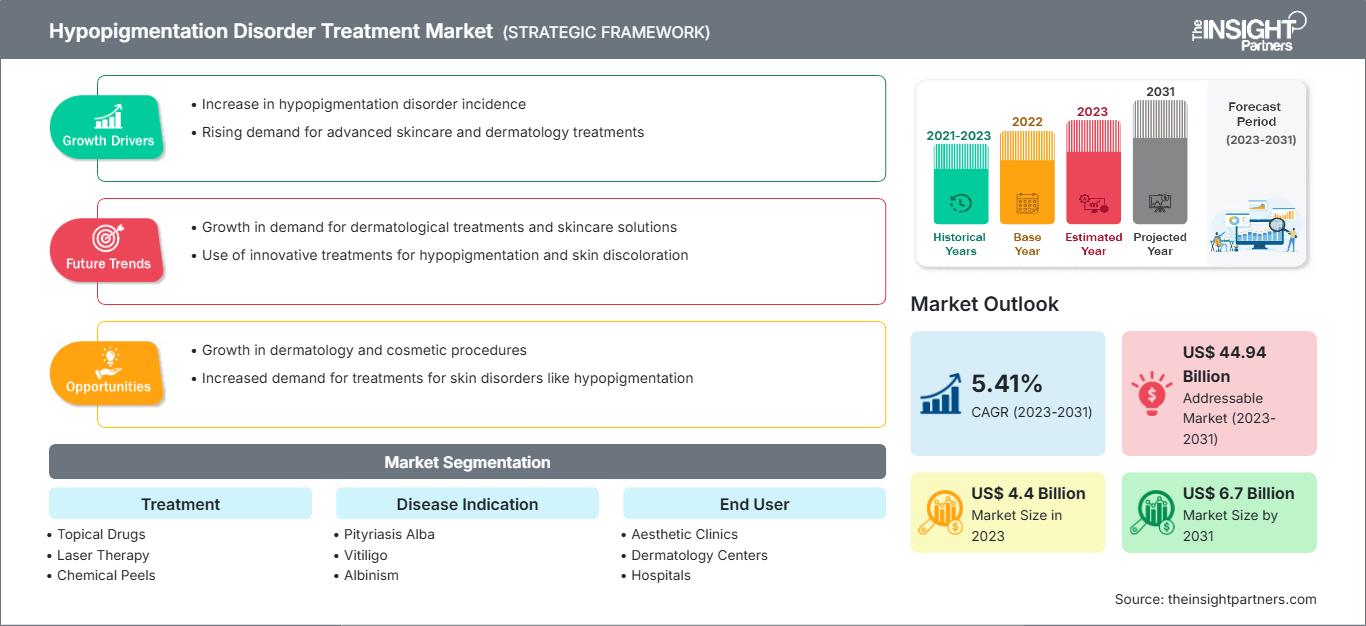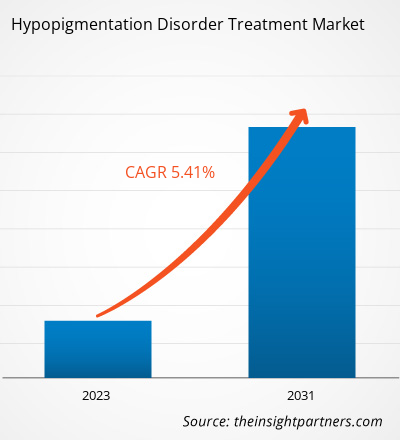[研究报告] 色素减退症治疗市场价值预计将从2023年的44亿美元增长到2031年的67亿美元;预计该市场在2023年至2031年期间的复合年增长率为5.41%。
市场洞察和分析师观点:
色素减退症可能进一步发展为脱色症。这是一种皮肤色素水平低于最佳水平的疾病,不同于由于色素完全去除而发生的脱色症。推动色素减退症治疗市场增长的主要因素是人们对色素减退症认识的不断提高、美容治疗技术的进步以及老龄化人口的持续激增。此外,预计未来几年,与色素减退相关的疾病(例如白化病、色素减退后和白癜风)发病率的上升将推动色素减退症治疗市场的发展。此外,消费者在皮肤健康方面的支出不断增长以及对治疗相关意识的提高,预计将在不久的将来使该市场受益。天然和植物成分的引入预计将在未来几年推动色素减退症治疗市场的趋势,因为这些产品迄今为止在满足全球药妆产品需求方面发挥了关键作用。另一方面,美容治疗和手术的成本制约了市场的增长。
根据国家临床试验 (NCT) 注册中心的数据,2020 年 6 月,因塞特公司对鲁索替尼进行了一项 II 期临床试验,以评估其在美国受试者中治疗白癜风的安全性和有效性。因此,与色素减退症相关的临床试验数量的增加是支撑市场的另一个关键因素。
增长动力与挑战:
色素减退症患病率的上升推动了市场的增长
白色糠疹、白癜风、白化病和炎症后色素减退是与色素减退症相关的主要疾病适应症。白癜风是世界各地常见的疾病适应症。根据2023年12月发表在《皮肤病学实用与概念》上的一项研究,白癜风是一种影响两性的常见皮肤病。然而,白癜风在女性中更为常见,超过60%的患者在30岁之前发病。预计白癜风发病率和患病率的上升将进一步推动色素减退治疗的需求增长。
根据2023年3月发表在《扎加齐格大学医学杂志》上的一篇文章,色素减退症是儿科常见的一类皮肤病;色素减退症的患病率在不同国家有所不同,从3.6%到9.9%不等。此外,微创手术的出现和应用、更短的住院时间、更少的疼痛和更少的手术并发症,都是微创手术日益普及的关键。根据美国整形外科医师协会 (ASPS) 2021 年的数据,自 2000 年以来,美国实施的微创美容手术数量激增近 200%。因此,人们对微创美容手术的日益青睐进一步推动了色素减退症治疗市场的增长。另一方面,针对白癜风和白化病等疾病的光疗法费用高昂。此外,治疗白癜风的外科手术费用也非常昂贵。因此,高昂的治疗费用限制了此类手术的普及,从而限制了色素减退症治疗市场的增长。
自定义此报告以满足您的要求
您将免费获得任何报告的定制,包括本报告的部分内容,或国家级分析、Excel 数据包,以及为初创企业和大学提供超值优惠和折扣
色素减退症治疗市场: 战略洞察

-
获取本报告的主要市场趋势。这个免费样本将包括数据分析,从市场趋势到估计和预测。
报告细分和范围:
色素减退症治疗市场分析考虑了以下细分市场:治疗、疾病指征和最终用户。色素减退症治疗市场报告的地理范围包括北美(美国、加拿大和墨西哥)、欧洲(英国、德国、法国、意大利、西班牙和欧洲其他地区)、亚太地区(中国、日本、印度、澳大利亚、韩国和亚太其他地区)、中东和非洲(阿联酋、沙特阿拉伯、南非和中东及非洲其他地区)以及南非和中美洲(巴西、阿根廷以及南美洲和中美洲其他地区)。
细分分析:
基于治疗的洞察
根据治疗方法,市场细分为外用药物、激光疗法、化学换肤、微晶磨皮、光疗等。外用药物在2023年占据了色素减退症治疗市场的最大份额,预计在2023年至2031年期间将实现最高的复合年增长率。
基于疾病适应症的洞察
根据疾病适应症,色素减退症治疗市场细分为白色糠疹、白化病、白癜风、炎症后色素减退等。到2023年,白癜风细分市场将占据相当大的市场份额,预计在2023年至2031年期间将实现最高的复合年增长率。
基于终端用户的洞察
就终端用户而言,市场分为美容诊所、皮肤科中心和医院。美容诊所细分市场在2023年占据了色素减退症治疗市场的最大份额;预计在2023年至2031年期间将实现最高的复合年增长率。
色素减退症治疗
色素减退症治疗市场区域洞察The Insight Partners 的分析师已详尽阐述了预测期内影响色素减退症治疗市场的区域趋势和因素。本节还讨论了北美、欧洲、亚太地区、中东和非洲以及南美和中美洲的色素减退症治疗市场细分和地域分布。
色素减退症治疗市场报告范围
| 报告属性 | 细节 |
|---|---|
| 市场规模 2023 | US$ 4.4 Billion |
| 市场规模 2031 | US$ 6.7 Billion |
| 全球复合年增长率 (2023 - 2031) | 5.41% |
| 历史数据 | 2021-2023 |
| 预测期 | 2023-2031 |
| 涵盖的领域 |
By 治疗
|
| 覆盖地区和国家 |
北美
|
| 市场领导者和主要公司简介 |
|
色素减退症治疗市场参与者密度:了解其对业务动态的影响
色素减退症治疗市场正在快速增长,这得益于终端用户需求的不断增长,而这些需求的驱动因素包括消费者偏好的演变、技术进步以及对产品优势的认知度的提升。随着需求的增长,企业正在扩展产品线,不断创新以满足消费者需求,并抓住新兴趋势,从而进一步推动市场增长。

- 获取 色素减退症治疗市场 主要参与者概述
区域分析:
2023年,北美占据色素减退症治疗市场的最大份额,预计在预测期内仍将保持其主导地位(就份额而言)。美国在该地区(份额最大)乃至全球市场都占据主导地位。完善的医疗保健基础设施、人们日益增强的皮肤健康意识、与色素减退症相关的疾病患病率的上升,以及为炎症后色素沉着过度患者提供有吸引力的治疗方案的公司数量众多,这些都是推动北美市场增长的重要因素。此外,随着亚洲人审美标准的不断提高,大量公司进入市场,以及老牌企业的持续增长,这些都是推动亚太地区色素减退症治疗市场规模扩大的关键因素。
竞争格局和重点公司:
色素减退症治疗市场预测可以帮助该市场的利益相关者规划其增长战略。艾尔建 (Allergan)、修丽可 (SkinCeuticals)、皮尔法伯集团 (Pierre Fabre Group)、因塞特 (Incyte Corporation)、Episciences Inc.、Phio Pharmaceuticals、欧邦琪 (Obagi Cosmeceuticals LLC)、Alvogen、贝拉·奥罗拉 (Bella Aurora) 和艾伯维 (AbbVie) 是色素减退症治疗市场报告中介绍的几家重点公司。这些公司专注于扩大其产品供应,以满足全球日益增长的消费者需求。他们的全球影响力使他们能够服务众多客户。
- 历史分析(2 年)、基准年、预测(7 年)及复合年增长率
- PEST和SWOT分析
- 市场规模、价值/数量 - 全球、区域、国家
- 行业和竞争格局
- Excel 数据集
近期报告
客户评价
购买理由
- 明智的决策
- 了解市场动态
- 竞争分析
- 客户洞察
- 市场预测
- 风险规避
- 战略规划
- 投资论证
- 识别新兴市场
- 优化营销策略
- 提升运营效率
- 顺应监管趋势






















 获取免费样品 - 色素减退症治疗市场
获取免费样品 - 色素减退症治疗市场